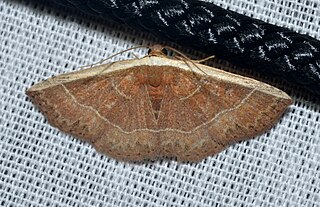Upothenia is a monotypic moth genus of the family Erebidae. Its only species, Upothenia acutipennis, is known from Costa Rica. Both the genus and the species were first described by Schaus, the genus in 1913 and the species one year earlier.

Autoba is a genus of moths of the family Erebidae. The genus was erected by Francis Walker in 1863.
Barastrotia is a monotypic moth genus of the family Noctuidae described by Warren in 1913. Its only species, Barastrotia metalophota, was first described by George Hampson in 1898. It is found in Khasis in north-eastern India and Bangladesh.
Ceratostrotia is a monotypic moth genus of the family Noctuidae described by Warren in 1913. Its only species, Ceratostrotia melanchlaena, was first described by Swinhoe in 1891. It is found in India.

Corgatha is a genus of moths of the family Erebidae erected by Francis Walker in 1859.
Dysgnathia is a genus of moths of the family Noctuidae. The genus was described by Warren in 1913.

Laspeyria is a genus of moths of the family Erebidae erected by Ernst Friedrich Germar in 1810.
Lophomilia is a genus of moths of the family Erebidae. The genus was described by Warren in 1913.

Loxioda is a genus of moths of the family Erebidae. The genus was described by Warren in 1913.
Mesocopsis is a monotypic moth genus of the family Noctuidae described by Warren in 1913. Its only species, Mesocopsis posticata, was first described by Francis Walker in 1866. It is found in Borneo.
Mesophractias is a genus of moths of the family Noctuidae. The genus was described by Warren in 1913.
Mesoruza is a monotypic moth genus of the family Noctuidae. Its only species, Mesoruza kuehni, is found in the Kai Islands and New Guinea. Both the genus and species were first described by Warren in 1913.
Obana is a genus of moths of the family Erebidae. The genus was erected by Francis Walker in 1862.
Orthoruza is a monotypic moth genus of the family Noctuidae. Its only species, Orthoruza niveipuncta, is found in New Guinea. Both the genus and species were first described by Warren in 1913.

Oruza is a genus of moths of the family Erebidae erected by Francis Walker in 1862.
Oxytrita is a monotypic moth genus of the family Noctuidae described by Warren in 1913. Its only species, Oxytrita bipars, was first described by George Hampson in 1907. It is found in Khasis and Kanara, both in what was then British India.
Parachabora is a genus of moths of the family Erebidae. The genus was described by Warren in 1889.
Physulodes is a monotypic moth genus of the family Erebidae described by Warren in 1889. Its only species, Physulodes eupithecialis, was first described by Achille Guenée in 1854.
Stenocryptis is a monotypic moth genus of the family Noctuidae. Its only species, Stenocryptis punctata, is found in the Khasi Hills of north-eastern India. Both the genus and species were first described by Warren in 1913.
Toanodes is a monotypic moth genus of the family Noctuidae described by Warren in 1913. Its only species, Toanodes rotundipennis, was first described by George Hampson in 1910. It is found on Woodlark Island in Papua New Guinea.




